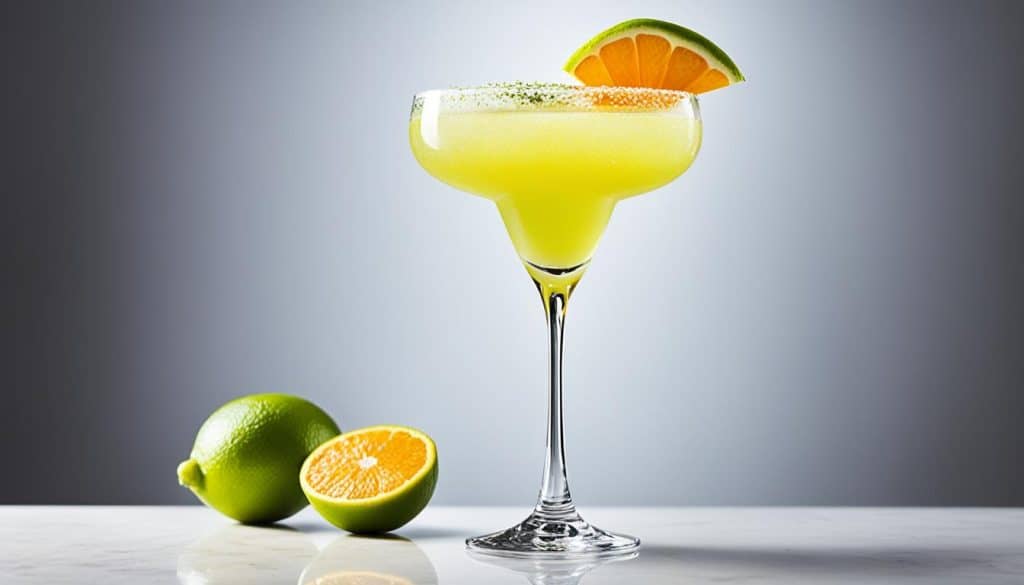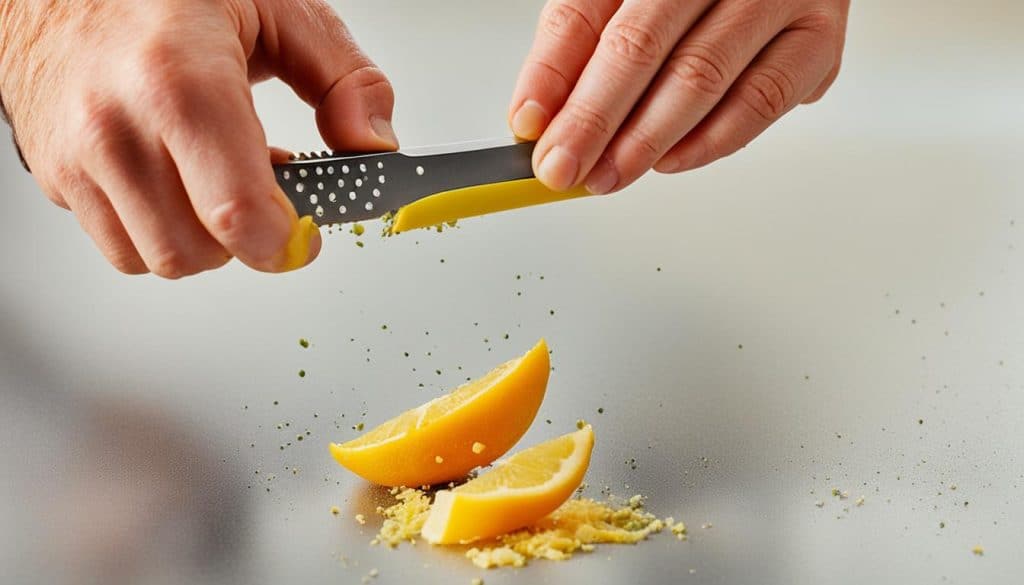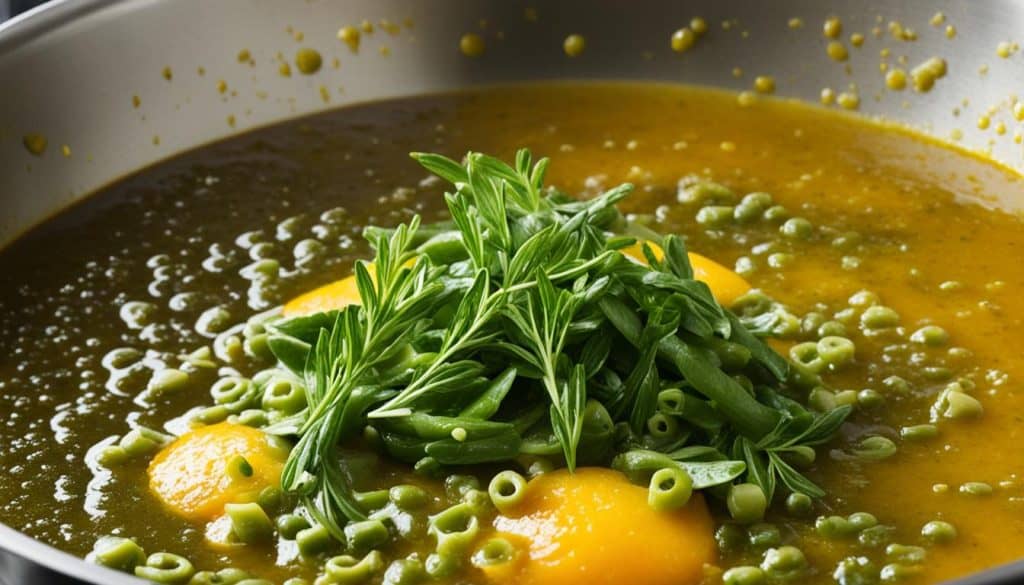Ever wondered how to make your dishes amazing? The secret is in the small details that boost flavors and thrill your taste buds. Zesting is one such technique that brings a burst of flavor to both sweet and savory dishes.
I once took a cooking class where a chef showed us how to zest citrus fruits. Watching him zest, I was amazed at how it changed the dishes.
We learned that different zesting methods give different results. For big zest curls, the chef suggested holding the lemon like a baseball and zesting in one long motion. This is great for garnishing desserts or adding citrus to salads.
We also learned to make lemon peel spirals with a channel knife. This method creates thick, beautiful spirals perfect for garnishing cocktails.
Then, the chef taught us to use a vegetable peeler for wide lemon peel strips. These strips can be used to flavor lemonade or chickpeas, adding a simple yet effective touch to dishes.
Tasting these dishes, I was amazed by the vibrant flavors. Zesting opened up a new world of taste for me.
Curious about how zesting can change your cooking? Keep reading. We’ll cover zesting tips, adding zest to food, and more.
So, get ready to start a flavorful journey and explore the magic of zesting!
Key Takeaways:
- Zesting is a technique that can elevate the flavors of your dishes.
- Different zesting techniques yield different results, such as larger curls of zest or lemon peel spirals.
- Wide strips of lemon peel can be used to infuse lemonade or dishes with a citrusy flavor.
- Zesting adds a vibrant and tangy dimension to both sweet and savory recipes.
How to Zest for Garnishes
Lemon zest is perfect for making beautiful garnishes for cocktails and desserts. It adds a burst of citrus flavor and makes dishes look and smell great. Here are some tips to help you make the perfect garnish for your drinks or desserts.
1. The Right Tools
Choosing the right tool is key for zesting. A lemon zester is the best choice. It lets you get the zest without the bitter pith. This way, you get only the tasty citrus oils.
2. Technique for Cocktail Garnishes
For cocktail garnishes, use a channel knife. Hold the lemon steady and carve a spiral shape with the knife. This makes beautiful garnishes that will wow your guests.
3. Creating Candied Citrus Peels
Want to make your garnishes even better? Try candied citrus peels. First, blanch the lemon curls to remove bitterness. Then, simmer them in a sugar and water syrup until they’re clear.
After that, coat them in sugar and let them dry. These candied peels are great as garnishes or a sweet snack.
4. Experiment with Different Citrus Fruits
Don’t just use lemon zest. Try zesting limes, grapefruits, and other citrus fruits too. Each one adds a unique flavor and aroma to your dishes.

Next time you want to add freshness to your drinks or desserts, use your lemon zester. From garnishes to candied peels, zesting opens up many ways to improve your dishes.
Adding Flavor to Food with Zest and Spices
Zest and spices are key to making your favorite dishes taste better. Zesting is often linked with citrus fruits, but many other ingredients can also enhance flavors. These include ingredients like onions, carrots, and celery, which add depth to stocks and soups.
Spices can take your meals to the next level. They’re a big part of many global cuisines, from Indian curry powders to Mexican chili blends. These spices add depth, complexity, and a bit of heat.
When using spices, grind them yourself for the best flavor. A good spice grinder or mortar and pestle can help. Making your own spice blends not only fills your kitchen with amazing smells but also gives you unmatched flavors.
“A great way to utilize spices is by creating a delicious barbecue dry rub. Combine equal parts of paprika, garlic powder, onion powder, dark chili powder, cumin, salt, fresh ground black pepper, and brown sugar for a mouthwatering blend that will take your grilled meats to the next level.”
There are more ways to add flavor besides zesting and spices. Ingredients like onions, carrots, and celery are great for stocks and soups. Fresh citrus juice and herbs can also add a burst of freshness to your dishes.
Citrus fruits are the top choice for zesting. Lemon zest is especially popular, used in both sweet and savory dishes. The Zyliss 2 in 1 Zester makes zesting lemons quick and clean, unlike traditional methods.

Lemon zest is versatile, used in baking, savory dishes, cocktails, and even meat rubs. Its bright flavor is perfect for Moroccan recipes, adding a unique twist to your cooking.
Always wash citrus fruits before zesting to remove the wax coating. This helps get the flavorful oils from the skin. Be gentle when zesting to avoid the bitter white pith.
Pro Tip: Blooming zest in fat like butter releases oils, boosting flavor without the sourness of the juice.
Other citrus fruits like limes and grapefruits can also be zested. Each has its own unique taste, letting you experiment with different recipes.
Zest isn’t just for flavor; it’s also a great garnish. Add zest to pasta, bean stews, or salads for a pop of color and flavor.
The key to good zesting is to get the bright skin part and avoid the bitter pith. This ensures you get the best flavors and aromas.
Zest and spices can truly transform your cooking. Whether you’re adding zest to a classic recipe or making your own spice blends, they can elevate your dishes’ flavors.
Zesting in Baked Goods
Zest can change the game in baking. It makes pastries and breads taste better. Adding citrus zest to lemon bars, orange cakes, or zesty cookies adds a burst of flavor.
But how do you zest citrus fruits perfectly? You can use a vegetable peeler, a microplane grater, or a lemon zester. Each tool has its own way to get the best flavor.
When zesting, handle the fruits carefully and remove stickers first. Take only the outer yellow layer to avoid the bitter white pith. This layer has the citrusy flavor you want without the bitterness.
The Microplane Classic Zester Grater is a top choice for zesting. It costs $32 on Amazon.com and is loved by many bakers and chefs. I suggest having two zesters – one for citrus and another for other ingredients. This keeps flavors pure.
Choose organic fruits for zesting to avoid contaminants. Lemons work well for zesting because of their thick skin. Malta oranges also have thick skin, making zesting easier.
Proper technique is key when zesting. Grate zest over the batter to keep oils and aroma in. Don’t zest with your hands to avoid losing oils. Use a zester like the Microplane to get all the flavors.
To mix zest into your recipe well, whisk it with a little liquid first. This ensures the flavors blend in evenly and prevents zest clumps. Use fine zest unless you’re straining the batter later.
You can dry zest strands for decoration or turn them into zest powder. Rub zest with sugar, spread it to dry, grind it, strain it, and store it in an airtight container. This way, you can use it later.
Zesting adds a burst of citrus flavor to baked goods, making them unforgettable. Experiment with different fruits and techniques to find your favorite. Remember, freshness is crucial when it comes to zest. So, grab your zester and let the flavors shine!
Creating Balanced Pan Sauces
Pan sauces make grilled meats taste better. They’re simple but powerful. The secret is finding the right flavor balance. Adding fresh citrus zest is a key technique for this balance.
Using pan drippings, stock, and wine makes a rich sauce. But, this can make the flavor too heavy. Adding fresh citrus zest at the end brings a fresh, acidic taste. This cuts through the richness and balances the flavors.
Chef Jason Hawk says one lemon can give about 1 tablespoon of zest. It’s important to use fresh zest for the best flavor. To keep the zest fresh, use it within 24 hours of zesting.
Enhancing Flavor with Homemade Stock and Fresh Ingredients
For great pan sauces, use top-quality, fresh ingredients. Homemade stock takes your sauce to the next level. It adds a depth of flavor that store-bought stock can’t match.
Thickening the Sauce for Perfect Consistency
There are ways to make your pan sauce just right. You can add starch, one tablespoon for every 200ml of liquid. Or use flour, two teaspoons per liter of liquid, or make a roux with melted butter. These methods give your sauce a smooth texture that sticks to the meat.
Creating Pan Sauces: The Technique and Tasting as You Cook
To make pan sauces, start by deglazing the pan with wine, cider, or broth. Then, add butter and flour to create a rich sauce. Always taste the sauce as you go to adjust the flavors and keep them balanced.
Choosing the Right Sauce for Your Meal
Choosing the right sauce can make your meal better. Whether it’s a red wine reduction with steak or lemon butter sauce with chicken, the right sauce adds complexity to your dish.
Creating great pan sauces needs attention to detail and a good sense of flavor balance. Adding fresh citrus zest is a great way to balance the flavors. So, next time you grill, try a pan sauce with fresh citrus zest to elevate your dish.

Final Thoughts on Zesting and Flavor Enhancement
Zesting changes the game in cooking by boosting flavors. Adding orange, lemon, or lime zest to your recipes makes them taste and smell better. It’s great for everything from sweet cookies to big slow cooker meals, adding a fresh citrusy touch.
Choosing the right tools for zesting is crucial. Tools like the IQ Better zester or microplane zesters make it easy to get the zest out. They help remove the outer skin, which is full of oils that add flavor and aroma. Make sure to avoid the bitter pith and go for the golden zest instead.
Keeping your zest fresh is important. Store it in the fridge or freezer to keep its flavor. Also, always juice your citrus fruits after zesting to get the most juice out. This can make tangy dressings, sauces, and even quick buttermilk substitutes.
If you love cooking or are just starting, don’t overlook zesting’s power. Citrus zest adds amazing flavors and smells to your food. With the right tools and a bit of zest, your cooking will be incredibly tasty.


